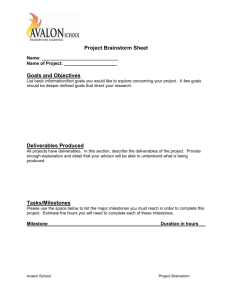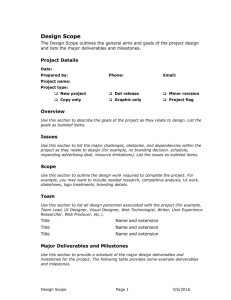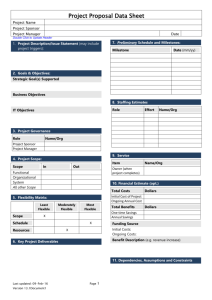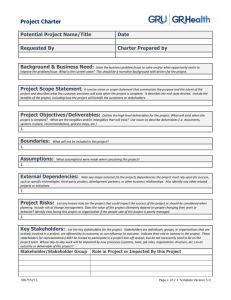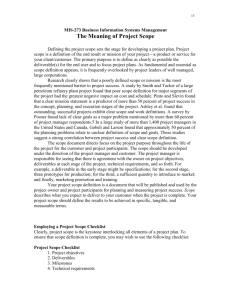Planning and Managing Multiple Small Projects
advertisement
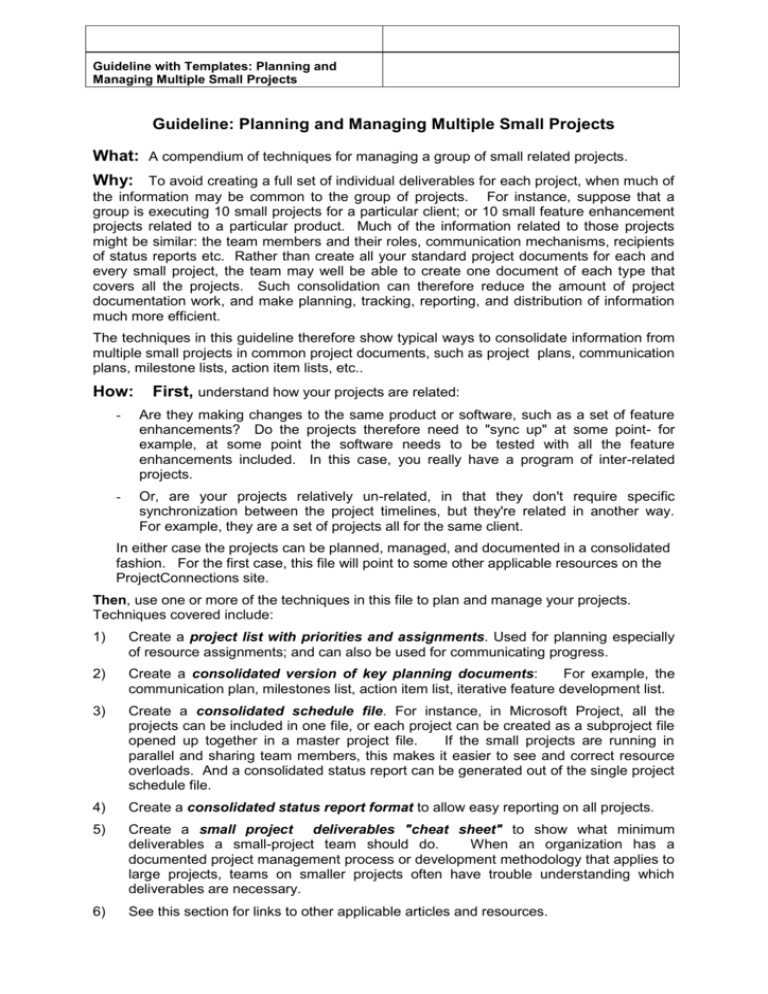
Guideline with Templates: Planning and Managing Multiple Small Projects Guideline: Planning and Managing Multiple Small Projects What: A compendium of techniques for managing a group of small related projects. Why: To avoid creating a full set of individual deliverables for each project, when much of the information may be common to the group of projects. For instance, suppose that a group is executing 10 small projects for a particular client; or 10 small feature enhancement projects related to a particular product. Much of the information related to those projects might be similar: the team members and their roles, communication mechanisms, recipients of status reports etc. Rather than create all your standard project documents for each and every small project, the team may well be able to create one document of each type that covers all the projects. Such consolidation can therefore reduce the amount of project documentation work, and make planning, tracking, reporting, and distribution of information much more efficient. The techniques in this guideline therefore show typical ways to consolidate information from multiple small projects in common project documents, such as project plans, communication plans, milestone lists, action item lists, etc.. How: First, understand how your projects are related: - Are they making changes to the same product or software, such as a set of feature enhancements? Do the projects therefore need to "sync up" at some point- for example, at some point the software needs to be tested with all the feature enhancements included. In this case, you really have a program of inter-related projects. - Or, are your projects relatively un-related, in that they don't require specific synchronization between the project timelines, but they're related in another way. For example, they are a set of projects all for the same client. In either case the projects can be planned, managed, and documented in a consolidated fashion. For the first case, this file will point to some other applicable resources on the ProjectConnections site. Then, use one or more of the techniques in this file to plan and manage your projects. Techniques covered include: 1) Create a project list with priorities and assignments. Used for planning especially of resource assignments; and can also be used for communicating progress. 2) Create a consolidated version of key planning documents: For example, the communication plan, milestones list, action item list, iterative feature development list. 3) Create a consolidated schedule file. For instance, in Microsoft Project, all the projects can be included in one file, or each project can be created as a subproject file opened up together in a master project file. If the small projects are running in parallel and sharing team members, this makes it easier to see and correct resource overloads. And a consolidated status report can be generated out of the single project schedule file. 4) Create a consolidated status report format to allow easy reporting on all projects. 5) Create a small project deliverables "cheat sheet" to show what minimum deliverables a small-project team should do. When an organization has a documented project management process or development methodology that applies to large projects, teams on smaller projects often have trouble understanding which deliverables are necessary. 6) See this section for links to other applicable articles and resources. Planning and Managing Multiple Small Projects 1) Project List with Priorities and Assignments It may be useful to have a master project list that shows what the group is working on, and the relative priorities of the projects. Simultaneous work on multiple small projects is often characterized by lots of task switching among projects. Having an easy-to-read prioritized project list can help make sure the team(s) know what's most important and allocates their time appropriately. If the client of the program tends to change priorities or make new requests often, the list can be kept updated as a living record of project priorities. The format in this embedded Excel file can be used to list the projects, score them according to their contribution to key business goals, capture delivery date for each project, and indicate key team members. 2) Consolidated Versions of Key Planning Documents (excerpt from ProjectConnections Premium template Communication Plan, edited to illustrate multiproject use). A typical technique is to create one document of each type (communication plan, risk list, action item list etc.) when a group is working together on multiple small projects. A "program manager" would own these consolidated documents and work with the project managers of the small projects to do the related planning and create the docs. Thus a team member working on 5 of the small projects doesn't have to look at 5 communication plans, 5 milestones lists etc. And it's likely that a project manager is managing more than one of the small projects, so they don't have to deal with multiple instances of each planning document either. Finally, reporting to other stakeholders should be easier because the information for the projects is consolidated. 2a) Excerpt: Communications Plan for Multiple Small Projects A plan created by the team early in project to indicate their agreement on how the team will communicate important information during the project-- status, meetings, issues, deliverables access, and design/ document reviews. Client Name or Program name and Project List: The following projects are being worked on for Client X during Q3 and Q4 of 2003: Project 1: Deliver update to application X for new user interface functions Project 2: Deliver performance enhancements to database ,,,,, Etc. Continued next page Planning and Managing Multiple Small Projects 1.0 Team members and Stakeholders: The Program Manager for this group of client projects, the Client, the project executive sponsor/champion , the individual project managers for various projects being done for this client, representatives from each cross-functional group, and the individual technical contributors on the projects. (Alternatively, if the project team is larger, the core team members may be a technical lead from each technical group participating in the project). Program Team Members and Stakeholders: ROLE Proj1 Proj2 Executive Sponsor Proj3 Proj4 Tom P. Sara H. Client Contact Kumar L. Technical lead Technical team members Carol M Ed S. Lynn K Barbara R. Ed S. Lynn K. Hector R., Pete M. Karen R., Elliott Y., Bob M. Vijay K., Rose L, Pete M., Karen R. Customer support rep Karen R., Pete M. Anke N. Sam C. Business rep User documentation rep Proj 6 John C. Program Mgr Project manager Proj5 Harold E. Tom W. Outside resources Sheri V. Colleen K. Tool Vendor X Diane W. Robert Jconsultant Contractors A,B: contract writers 2.0 Project Communication Resources: Collaboration space: All projects for this client will utilize a collaboration space at url: ________________. Master documents pertaining to all projects will reside there. Each project will have a sub-directory for any documents unique to that project. This space will be accessible through our intranet. It will also be accessible to the outside stakeholders listed above, with password protection on the space and any other security as required by company policy. The spaces will be used to store at a minimum Project Status summaries Action item list(s) Any project review documents that the core team needs access to Internal design review documents at the discretion of the functional groups Email distribution list All core and extended team members will be included on an email list with the name _____________. The overall program manager will set up and maintain changes to the master list. The individual project managers for the various client projects will Planning and Managing Multiple Small Projects create sub-lists if needed, including the Program Manager on any list. Any team member can use these lists to communicate with the team on matters that affect the entire team. 2.0 Formal Project Communications- Project Management Related Formal "project management" related communication will consist of written status reports, project plan updates, project team meetings, and monthly reports to the Executive Committee. All written communication will be emailed to all indicated stakeholders. Weekly Team meetings Responsibility and Format: The Program Manager is responsible for calling and leading a weekly meeting of team members across all the client projects. The meeting will follow a published agenda listing key objectives of the meeting, subjects to be covered and time allotment for each, and any materials team members should bring. Focus: Focus of weekly program meetings is review overall progress related to the promises we have made to our client across multiple projects. For each project, the team will quickly review upcoming milestones and identify any issues with making those milestones. Any issues raised will be either discussed in the meeting, or an action item assigned for work outside the meeting. Each project manager will have provided latest milestone status to the Program Manager a day ahead of the meeting. If a specific project team needs to cover additional detail related to their project only, they will do so following the main program-level status meeting. Who attends: All team members identified in section 1. A subset of the technical team may attend some meetings if deemed acceptable by the individual project manager and the program manager. Media/Tools: Meetings will be held face-to-face, except for remote core team members, who will participate via teleconference. The Program Manager will schedule the conference room and publish the conference room and a call-in conference line number via email no later than the day before the meeting. Ground Rules: An updated action items list will be distributed the following day. Monthly Executive Committee Meeting Responsibility and Format: The project manager will produce a summary project report for this meeting and review it with the Project Sponsor/Champion before the meeting. The project manager will present this report at the Executive Committee meeting. The report will follow the company format of several PowerPoint slides covering the follow highlights: Project Vision statement summary Progress against project milestones (milestone name, original date, and completion date or current forecast date) Upcoming milestones (milestone name, original date, current forecast date, responsible person) Changes to any Project Vision parameters in last period, and justification Issues threatening upcoming milestones and/or overall project success Planning and Managing Multiple Small Projects Who receives the communication: All team members/ stakeholders . Media/Tools: Status reports are published in Microsoft PowerPoint and must be compatible with PowerPoint97, since some extended team members do not have the later version. Ground Rules: Slides for this meeting must be turned in to the Executive Committee's administrative assistant 2 days before the monthly meeting. (end of consolidated Communications Plan excerpt) 2b) Excerpt: Consolidated Action Items, Key Decisions, Milestones The embedded Excel file contains one approach to creating action items, key decision, and milestones list for a program of multiple projects. Not only does this format keep track of those items for multiple projects in one place, it also consolidates those 3 project tracking documents into one file for each of access by team members. 2c) Example format: Planning iterative development projects See this embedded copy of a ProjectConnections.com Premium template for an example of how to use simple tables to plan and communicate iterative deliveries for one or more projects. Planning and Managing Multiple Small Projects 3) Creating a Consolidated Schedule A typical approach for using schedule programs for multiple small projects is to hold the schedules for all the projects in one file, or as subprojects linked into an MS Project master file. In both cases, each project shows up as a top-level summary line in the workbreakdown, with the project's detailed schedule info underneath. The schedules can be created in one file if the program manager is going to handle all the schedule updates etc. If individual project managers want to create and update their schedules, the program manager can own the master file, and each project manager edits their file and provides it (email, online posting etc.) to the Program Manager. When the program manager opens the master file, it will pick up the latest version of each individual project file. One benefit of having these schedules in one place is that members of the group are likely working on more than one of these projects at a time; having the schedules in one place, with resource names assigned to the blocks of work, allows the program manager and project managers to see if any of the people are overloaded - needed on 2 projects at once at exactly the same time etc. These issues can then be resolved by experimenting with moving tasks in time within individual projects, changing resource assignments, etc. For a book on using software to plan multiple small projects: http://www.westney.com/Publications.asp The first book listed on this page is specifically techniques for using planning software on a set of small projects. (It's also available through Amazon). A group planning technique for a project set is to have the team work together to create a high-level flow of the multiple projects and their deliverables and project interdependencies. The flow can then be transferred into a program like MS Project, but a big piece of the value comes from having the team members work on doing initial planning of the project set collaboratively. They all gain an understanding of the project set and goals; they may well unearth unforeseen dependencies between projects; and they may come up with new suggestions for how to sequence and assign the work based on seeing the big picture. Create a master list of all the end deliverables from the various projects, with due date. Put each deliverable on a post-it note; color code the notes by person who is accountable. Put banner paper on the wall of a conference room and mark off a timeline with whatever granularity is appropriate for your projects. Create "swim lanes" (rows) by project across the paper Place each post-it in the row for its project, at its delivery date. Sketch in or put on post-its interim deliverables or major chunks of work for each project, (color-coding or otherwise marking each item for who is doing the work), and place them in the appropriate timeframe on the timeline. Map the interdependencies between major work within a project, and between projects. This exercise may show places where the timeline for one or more projects has to be adjusted based on those dependencies. Look also for areas where similar work is needed on more than one project, and can be done once. Discuss any potential resource overload issues etc. and decide next steps This technique courtesy of one of our site contributors, Paula Martin of Martin Training (www.martintraining.net) Planning and Managing Multiple Small Projects 4) Creating a Multiple-Project Status Summary (excerpt from ProjectConnections.com Premium template Project Status Reports) Contents: Provides one page summary of current set of projects. Variations: You can add various columns to provide whatever info you want to convey. Bottom line: This status report is a good summary for functional managers to see the landscape of projects their people are being assigned to; and good for executives to understand where resources are being deployed and how those efforts are going. The delta columns at right point out quickly which projects are changing or slipping. The "resets" column indicates projects that had such radical change or issues that they were considered "restarted". This type table can be used for any set of projects for which it is useful to see "status at a glance". Example Format: Multi-project Status Summary Portfolio Name: ___Commercial Website____ Project PROJECT Priority NAME Category Resets Status Date: _____________ Phase FCS Date (First Customer Ship) 1 UI creation Usability 4 6/30/03 2 Dbase update Infrastructure 3 7/14/03 3 Traffic reporting Application 1 2 8/2/03 4 New billing module Infrastructure 1 3 8/31/03 5 Content 1 Content 2 8/1/03 6 Content 2 Content 1 10/1/03 7 Etc. Delta since Last Month Delta since July 02 1 week 3 weeks 1 week 8 9 10 11 12 This chart format is a typical of those produced by multi-project management tools. Planning and Managing Multiple Small Projects 5) Creating Small Project Methodology "Cheat Sheets" (excerpt from ProjectConnections.com Premium template Development Process Quick Reference) This section provides an example "quick reference" format showing how to use the phases of a larger PM or development methodology and a subset of deliverables to accomplish a smaller software project. This approach is handy when you've got a defined "big" methodology that has too much stuff and is possibly overwhelming to people doing smaller faster projects. The idea is to give them something really brief that says "if you're doing small project type X, use this subset of items from our big methodology." The author has used this approach to very good effect with software teams who had to do everything from 2 month feature enhancement projects to demo/proof of concept projects to fast maintenance releases. Project Phases: 1. Concept 2. Feasibility 3. Development 4. Validation 5. Production/ Commercialization 1. & 2. Concept/Feasibility: Create Vision and decide PL. Phases 1 and 2 are combined and fast - no Phase 1 signoff required. Deliverables are each one or two pages long and can be created in one file if desired. Hold a 1-hour PDR meeting to review with appropriate people and get a go-ahead on the rest of the project. If feature enhancements to an existing system, team may choose to update existing documents. 1.3 Project Vision Identify PL and team. 2.14 Innovations List and Chicken Test Definition, Risks and Contingency Identify technical risks, issues, and how to test/monitor 2.11 Functional Spec Create functional spec detail or update existing doc if required (Vision may contain all needed info). 2.15 PDR (Preliminary Design Review) Review high-level design, make decisions 2.16 Early development iterations, DDRs Check the feature design against the Vision. 2.17 Early Chicken Tests and CDR Test risky technical innovations and review results 2.18 Validation Testing Overview Plan Indicate all testing to be done, create or update plan. 2.21 Milestone List Identify key deadlines for the project 2.30 Feasibility Phase Sign-off Approve Vision and Plan and go to next phase 3. Development: 3.2 Design Documents As needed, create spec detail or update existing doc. 3.8 Chicken tests Test remaining technical risks 3.9 CDRs Review results to ensure risks are mitigated. 3.24 Coding, Code Reviews, Unit tests Code new features, review and test them 3.25 Code Freezes, Integration Builds Make new build for this iteration's integration 3.26 System Integration Testing Integrate the new features with the running system 3.27 Functional System Testing System-level testing by Engr before release to Validation 3.44 FDR (Final Design Review) Make sure team agrees development is complete. 3.47 Software Build Rel. for Validation Make official software release for Validation testing 3.50 Development Phase Signoff Management approves transition to Validation Planning and Managing Multiple Small Projects 4. Validation: May be done as part of a software release 4.4 Alpha Testing Internal independent validation by Software Quality 4.5 Design review of test data Review results of testing against completion criteria 4.18 Software Beta Build/Release Release software suitable for beta testing 4.23 Beta Testing Formal validation at a customer 4.25 Design review of test data Review results of testing against completion criteria 4.28 Software Build Release For Commercialization Make official software build for release 4.42 First Customer Ship Readiness Released Software is ready for official shipment to customer for revenue 4.44 Validation Phase Sign-off Management signoff to proceed to full release 5. Production/Commercialization: May be done as part of a software release 5.1 Release to Production Continued next page Finish documentation and perform handoff as needed to complete the project smoothly Planning and Managing Multiple Small Projects Recommended Team Members: Member Role/responsibility on project Notes Project Leader and Software Technical Lead Lead small team in defining the features requirements and quickly planning the development effort; and drive the completion of the work. Software Technical Lead may also create detailed specs Often same person on a small project Key Architect Systems or software architect provides their insights into impact of new features on existing architecture, performance, etc. as required. Software Engineer(s) Create specs (or receive from Software Technical Lead), develop new code, revise existing code Product Management representative Just up-front for input on feature requirements. May be one person for the entire SW release SQA representative Create/Update test plans. Carry out or observe and sign off on Validation testing May be one of the SQA people assigned to the entire SW release Operations/ Field Engineering Services representative Participate in reviews if needed, run beta tests if any. Create documentation for field installation, setup. May be one person for SW release Overseeing director Consult on issues. Release-level role. Key Milestones Milestone Original Target Date 1. & 2. Concept/Feasibility Phase Vision and Plan approved, Feasibility Signoff 3. Development Phase Each design complete Start integration tests Release Build for Validation 4. Validation Phase Alpha tests complete, rel SW build for Beta Beta tests complete, release software build for commercialization First customer ship readiness 5. Commercialization Phase Release to Production/Commercialization Current Projected Date Status Planning and Managing Multiple Small Projects 6) Other Resources Book on using software to plan multiple small projects: http://www.westney.com/Publications.asp The first book listed on this page is specifically techniques for using planning software on a set of small projects. (It's also available through Amazon). Article with some methodology for managing multiple IT projects Emphasis is on assigning priorities, understanding time allocated to various projects. http://www.zdnet.com.au/builder/manage/project/story/0,2000035082,20272279-1,00.htm Paper/ Case Study from BBC team: Finally, at this link you'll find a paper about approaches a BBC team used to manage multiple small projects, in this case including specific rapid development software techniques. Title: Agile Planning with a Multicustomer, Multi-project, Multi-discipline Team www.extremeprogramming.org/xpu/papers/paper14.doc

